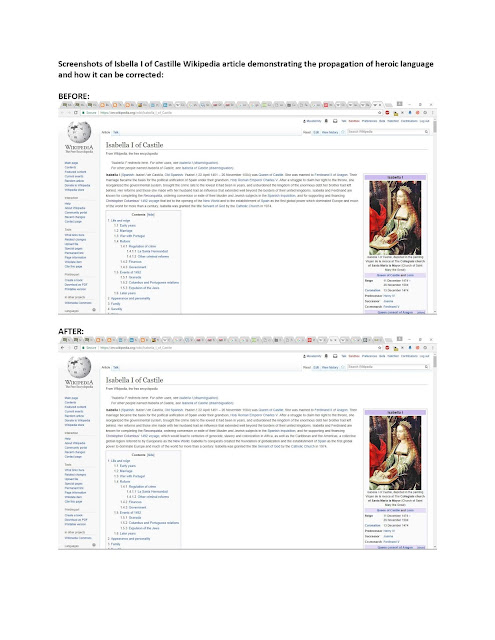How Heroic Language Works: An example at Wikipedia on "Isabella I of Castile"
In the original (prior to writing this post) introductory paragraph (seen below) about Isabella I of Castille there is no mention of the colonization, genocide and slavery, which came as a direct result of their adventures and conquests. Isabella who was the chief sponsor of Christopher Columbus, is framed as a heroic benefactor to Europe, Africa, the Caribbean and the Americas - and as a "Servant of God" by the Catholic Church As a frequent contributor to Wikipedia, I did a minor, but important edit, also seen below. Bold font at the end of each paragraph reflects the original and edited portion of heroic language in the article, which was updated to more accurately reflect historical truth. Screenshots follow text:
Isabella I (Spanish: Isabel I de Castilla, Old Spanish: Ysabel I; 22 April 1451 – 26 November 1504) was Queen of Castile. She was married to Ferdinand II of Aragon. Their marriage became the basis for the political unification of Spain under their grandson, Holy Roman Emperor Charles V. After a struggle to claim her right to the throne, she reorganized the governmental system, brought the crime rate to the lowest it had been in years, and unburdened the kingdom of the enormous debt her brother had left behind. Her reforms and those she made with her husband had an influence that extended well beyond the borders of their united kingdoms. Isabella and Ferdinand are known for completing the Reconquista, ordering conversion or exile of their Muslim and Jewish subjects in the Spanish Inquisition, and for supporting and financing Christopher Columbus' 1492 voyage that led to the opening of the New World and to the establishment of Spain as the first global power which dominated Europe and much of the world for more than a century. Isabella was granted the title Servant of God by the Catholic Church in 1974.
Isabella I (Spanish: Isabel I de Castilla, Old Spanish: Ysabel I; 22 April 1451 – 26 November 1504) was Queen of Castile. She was married to Ferdinand II of Aragon. Their marriage became the basis for the political unification of Spain under their grandson, Holy Roman Emperor Charles V. After a struggle to claim her right to the throne, she reorganized the governmental system, brought the crime rate to the lowest it had been in years, and unburdened the kingdom of the enormous debt her brother had left behind. Her reforms and those she made with her husband had an influence that extended well beyond the borders of their united kingdoms. Isabella and Ferdinand are known for completing the Reconquista, ordering conversion or exile of their Muslim and Jewish subjects in the Spanish Inquisition, and for supporting and financing Christopher Columbus' 1492 voyage, which would lead to centuries of genocide, slavery and colonization in Africa, as well as the Caribbean and the Americas; a collective global region referred to by Europeans as the New World. Isabella I's conquests created the foundation of globalization and the establishment of Spain as the first global power to dominated Europe and much of the world for more than a century. Isabella was granted the title Servant of God by the Catholic Church in 1974.
Isabella I (Spanish: Isabel I de Castilla, Old Spanish: Ysabel I; 22 April 1451 – 26 November 1504) was Queen of Castile. She was married to Ferdinand II of Aragon. Their marriage became the basis for the political unification of Spain under their grandson, Holy Roman Emperor Charles V. After a struggle to claim her right to the throne, she reorganized the governmental system, brought the crime rate to the lowest it had been in years, and unburdened the kingdom of the enormous debt her brother had left behind. Her reforms and those she made with her husband had an influence that extended well beyond the borders of their united kingdoms. Isabella and Ferdinand are known for completing the Reconquista, ordering conversion or exile of their Muslim and Jewish subjects in the Spanish Inquisition, and for supporting and financing Christopher Columbus' 1492 voyage that led to the opening of the New World and to the establishment of Spain as the first global power which dominated Europe and much of the world for more than a century. Isabella was granted the title Servant of God by the Catholic Church in 1974.
Isabella I (Spanish: Isabel I de Castilla, Old Spanish: Ysabel I; 22 April 1451 – 26 November 1504) was Queen of Castile. She was married to Ferdinand II of Aragon. Their marriage became the basis for the political unification of Spain under their grandson, Holy Roman Emperor Charles V. After a struggle to claim her right to the throne, she reorganized the governmental system, brought the crime rate to the lowest it had been in years, and unburdened the kingdom of the enormous debt her brother had left behind. Her reforms and those she made with her husband had an influence that extended well beyond the borders of their united kingdoms. Isabella and Ferdinand are known for completing the Reconquista, ordering conversion or exile of their Muslim and Jewish subjects in the Spanish Inquisition, and for supporting and financing Christopher Columbus' 1492 voyage, which would lead to centuries of genocide, slavery and colonization in Africa, as well as the Caribbean and the Americas; a collective global region referred to by Europeans as the New World. Isabella I's conquests created the foundation of globalization and the establishment of Spain as the first global power to dominated Europe and much of the world for more than a century. Isabella was granted the title Servant of God by the Catholic Church in 1974.
- right click to download -

Comments
Post a Comment